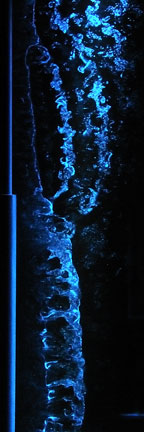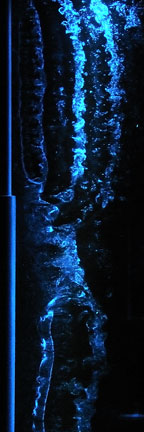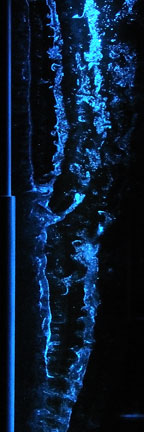Vortex Shedding in the Wake of a Step Cylinder
Chris Morton
Serhiy Yarusevych
Department of Mechanical Engineering
University of Waterloo
Ontario, Canada



In the sequence of images, water is flowing from left to right over a vertical circular cylinder with a single step change in diameter. The step cylinder is composed of two coaxially joined cylinders of different diameters. Small hydrogen bubbles introduced into the incoming flow are illuminated with a laser sheet to visualize shedding and interaction of spanwise vortices in the cylinder wake, i.e., vortices oriented vertically in the images. Due to the difference in diameters, the vortex shedding frequency in the wake of the small cylinder is higher than that in the large cylinder wake. This results in complex vortex connections between large cylinder and small cylinder vortices that can be seen in the images. Moreover, in addition to wake vortex shedding behind the large and small cylinders, a distinct vortex cell near the step on the large cylinder side presents itself cyclically.
In the first image, vortex shedding parallel to the cylinder axis is observed in the wake of the large cylinder. Over time, vortices in the large cylinder wake become obliquely angled towards the step and eventually a distinct vortex shedding cell can be observed near the step, bordered by the large and small cylinder vortices below and above, respectively (second image). The second image shows a vortex in this middle cell being shed out of phase with two successive large cylinder vortices yet maintaining connections with both of them.
Eventually, the middle cell vortices re align with the large cylinder vortices, such that the former becomes difficult to distinguish via flow visualization (third image). In the third image, oblique vortex shedding at an angle away from the step is observed in the wake of the large cylinder. After a few more vortex cycles, the shedding becomes parallel with the cylinder axis again, marking the beginning of the next middle cell cycle.
This work was supported by NSERC.
References
These images have not been published.
Reporters and Editors
The images can be reproduced only with authors' permission and the reference to authors' names, affiliation, and the corresponding poster presentation. Email Jason Bardi for contact information.
